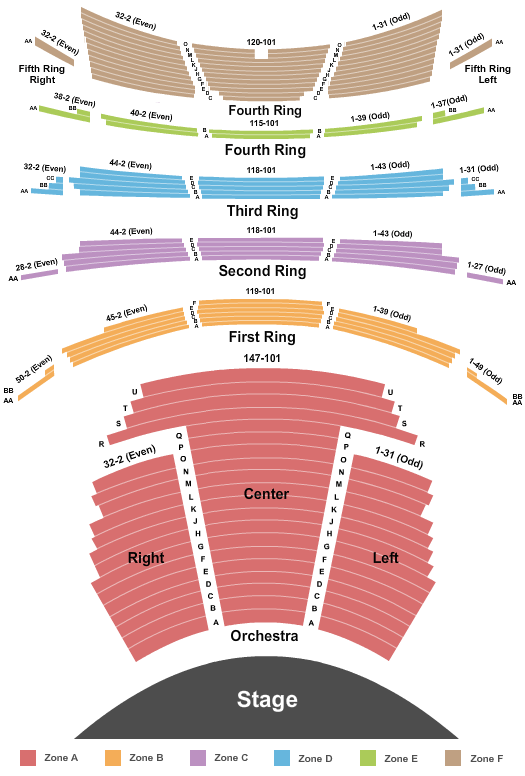David H Koch Theater Seating Chart

David H Koch Theater has an incredible and unique seating arrangement that delivers great acoustics for all on-stage performances. Besides the orchestra level, there are four main rings and two smaller rings on both sides of the venue.
NOTE: Seating configuration may be subject to change depending on the type of event. Please check the seating map displayed for the event when selecting your tickets.
Secure your desired seats today by purchasing your tickets now. Visit the David H Koch Theater schedule to view all upcoming events.
To view our ticket & refund policy please visit the ticket information page.
Once you understand more about the David H. Koch Theater seating chart in New York City, you’ll feel more confident in selecting optimal seats for your preferences and budget. The theater seats just over 2,500 people across the orchestra level and five rings. Each level offers distinct viewing experiences and price points, so be sure to weigh the benefits before you purchase your ticket.
Orchestra Level
Orchestra Level offers the closest proximity to the stage, with left, center, and right sections available. Two main aisles divide the space, with center sections offering the most sought-after views.
- Rows A through C place patrons extremely close to the stage. These front rows work well for viewers who want to see dancers’ facial expressions and appreciate technical details. Some choreography designed for elevated viewing may be partially lost from this proximity.
- Rows D through P in the center orchestra section represent prime seating. You’ll have ideal viewing angles that capture intimate details and overall stage compositions. These seats command premium prices but deliver value.
- Side sections in the orchestra require slight body angling to view the center stage. Still, the theater’s shallow design means that even extreme side seats maintain reasonable proximity to the performers. These sections offer value pricing for patrons prioritizing budget over perfect centering.
Accessible seating is integrated throughout the orchestra level. Wheelchair spaces include companion seating, and the theater can accommodate transfers.
First Ring
First Ring offers perhaps the best overall value in the theater, with seats providing elevated perspectives at prices below premium orchestra. This level combines proximity with elevation, revealing choreographic patterns while maintaining your connection to the performers.
The front rows of First Ring deliver exceptional views from which to appreciate dancers’ footwork and floor patterns. Center First Ring seats rival front orchestra locations for viewing quality.
Second Ring
Second Ring puts you at moderate elevation, providing comprehensive stage views. Do you like to prioritize seeing complete choreographic compositions over maximum proximity to performers? The elevation clearly highlights geometric patterns in corps de ballet work.
Choreographers like George Balanchine created works with elevated viewing in mind. This level delivers the perspective envisioned all those years ago.
Third Ring
Third Ring sits at an increased elevation with even steeper viewing angles. This level offers budget-friendly access to performances while maintaining the theater’s characteristic excellent sightlines.
The steeper angle from the Third Ring section emphasizes choreographic patterns and spatial relationships well. This perspective works especially well for ballets featuring large corps formations and geometric precision.
Fourth Ring
Fourth Ring is that much higher, representing the most budget-conscious option before reaching Fifth Ring right at the top. Fourth Ring suits patrons who may want to attend multiple performances and maximize their number of shows within a fixed budget.
The elevation provides a unique perspective on the show’s choreography. Patterns invisible from lower levels become apparent, and the mathematical precision of ballet formations reveals itself more clearly.
Fifth Ring
Fifth Ring represents the theater’s highest level and has fewer seats available. This level offers the most affordable access to performances, often attracting students, seniors on fixed incomes, and devoted ballet fans who want to maximize their season’s attendance.
The height and distance mean facial expressions and subtle performance details become difficult to see without opera glasses. However, the overall production remains visible, music sounds clear, and the theatrical experience remains intact.
Accessible and Companion Seating
Accessible seating is available on selected levels. Wheelchair spaces include companion seating, allowing guests using wheelchairs to enjoy the performance alongside their companions.
The theater can provide assisted listening devices upon request to enhance the experience for patrons with hearing impairments. These devices connect directly to the theater’s sound system, offering precise and adjustable amplification.
The box office team is available to assist with accessibility needs and answer any related questions. They encourage their guests to reach out before purchasing tickets so that a dedicated staff member can explain the available options and recommend suitable seating.
